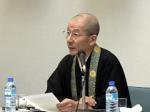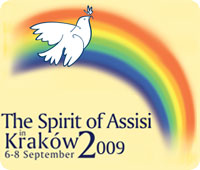
Najwyższy Doradca Buddyzmu Tendai, Japonia
|
The 23rd Gathering of Prayer for World Peace
Hosted by the Community of Sant’Egidio & the Archdiocese of Krakow
September 7, 2009
John Paul II and the Spirit of Assisi
Gijun Sugitani
Representative Extraordinary, and Advisor to Tendai-Shu Japan
Chairman and dear friends, allow me to express my deepest respect for all of you. It has been 20 years since my last visit to Poland, and it is a great joy to be in Krakow once again. My last visit was before the collapse of the Berlin Wall; however, even then, I felt that the good people of Poland were already brimming with anticipation of the changes that were about to come.
As you already know, having been spared the ravages of World War II, historical Krakow was able to preserve its many wonderful ancient cultural heritages. I come from Mt. Hiei, the holiest of places for Tendai-Shu Buddhism, near the ancient and beautiful city of Kyoto. Kyoto, also spared damage in the World War II, was able to protect its cultural heritage. Because these two beautiful cities were both blessed with this remarkably good fortune, I feel especially close to Krakow.
Krakow is also the home of Jagiellonian University, an outstanding school, and the alma mater of the father of modern astronomy, Mikoaj Kopernik. This university is also the proud alma mater of Pope John Paul II. It is a great honor for me to be given the opportunity to speak about John Paul II and the Spirit of Assisi in a place so closely associated with him.
A prayer for peace pilgrimage started out from Assisi in 1986 and arrived in Warsaw in 1989. After we offered prayers for peace in that wonderful city, we visited Auschwitz and Birkenau to place flowers and offer prayers for those who perished so horribly there. In the 20 years since then, we have held prayer gatherings in various regions of Europe. We returned once again to Auschwitz Birkenau. We resolve to confess our failings, swear an oath to make further efforts for peace afresh, and offer cordial prayers, recalling the words that His Holiness John Paul II spoke at in 2002, in his address for the Celebration of the World Day of Peace: “The enormous suffering of peoples and individuals, even among my own friends and acquaintances, caused by Nazi and Communist totalitarianism, has never been far from my thoughts and prayers.”
Pope John Paul II was born in the suburbs of Krakow. He faced the trauma of losing his mother when he was only nine and his elder brother when he was 12. Later, when he was a student, Jagiellonian University was closed after the Nazi invasion of his homeland. He had a hard life, surviving by earning his bread and butter working in a quarry. He lost his father when he was still 20. After turning 22, John Paul II attended an underground seminary to enter the priesthood. The pain and difficulty he experienced under the Nazi occupation must have formed the basis of his later activities as a man of the cloth.
Soon he became the archbishop of Krakow and was elected Pope in 1978. Based on his experience under the Communist regime in Poland, seeing firsthand the oppression of human rights, and freedom of speech and religion, he put all his efforts into the establishment of a world in which all people could live peacefully together as members of the human community.
Pope John Paul II reflected on his life and decided to reform the church. He participated in the Second Vatican Ecumenical Council and contributed to the creation of the Gaudium et Spes, “Joy and Hope” in Latin, the Pastoral Constitution on the Church in the Modern World. Next, in order to make the church more open, he sought dialogue with other religions, bringing the call and hope for unity beyond the Christian faith.
Interaction among religions requires that three important factors come into play.
(1) Equality.
(2) Respect.
(3) Understanding.
When he visited Japan in February of 1981, he invited religious leaders to the Vatican’s Embassy in Tokyo to speak with them about the need for dialogue and cooperation among the religions of the world in solving the difficult problems that face humanity. He told us, using the words of the 8th century Buddhist monk Saicho, that such dialogue and cooperation must be based on the desire to The highest expression of compassion is in action for the benefit of others, without thought to one’s own benefit. Saicho, one of the most well-known monks in Japanese history, was the founder of the Tendai Buddhist Denomination and the Buddhism temple at Mt, Hiei, a place known as the mother mountain of Japanese Buddhism, some 1,200 years ago. The Pope’s use of Saicho’s words made a positive impression on all of those at the meeting. By using these words, the Pope began the process of coming to know us and the process of opening a dialogue with us by expressing respect for us. This moved us and served as a cue to actively promote dialogue among the various religions.
I would like to mention another speech the Pope made during his visit in 1981. It was his Appeal for Peace at Hiroshima, where the world’s first atomic bomb was detonated. He expressed his strong commitment to world peace to prevent the loss of human life with the words: I wanted to make this visit to the Hiroshima Peace Memorial out of a deep personal conviction that to remember the past is to commit oneself to the future. This is the benevolence that the Pope, a man who would never forget the pain and suffering caused by war in his life, showed to those who had suffered in Hiroshima.
Let me now talk about Assisi, the starting point of this pilgrimage of our prayer for peace. October 28, 1986 was a very cold day in Assisi, as if it had been the middle of winter. However, the enthusiasm of those who wished for peace and gathered there seemed to take the chill out of the air. It was an unprecedented event in the long history of religion that religious leaders from throughout the world were gathered together at one time and one place to pray. The first Day of Prayer for World Peace was held in Assisi, organized by His Holiness Pope John Paul II.
The Pope spoke to everyone present: “I have chosen this town of Assisi as the place for our Day of Prayer for Peace because of the particular significance of the holy man venerated here - Saint Francis - known and revered by so many throughout the world as a symbol of peace reconciliation and brotherhood. Inspired by his example, his meekness and humility let us dispose our hearts for prayer in true internal silence.
Let us make this Day an anticipation of a peaceful world.” The Spirit of Assisi was born with these words and it has been kept alive ever since by people throughout the world.
The Community of Sant’Egidio continued living the spirit of Assisi, inviting the representatives of different religions throughout the world to gather together in Rome the following year. And since then, the Community has promoted pilgrimages of peace in various European cities year after year; and this year, we come to Krakow.
Etai Yamada, Tendai-Shu’s 253rd chief monk since Saicho founded the order, was invited to the gathering at Assisi for the Day of Prayer for World Peace. At that time, he proposed that they all meet next in Asia to pray for peace. And the following year, he convened a similar gathering, The 1st Religious Summit Meeting on Mt. Hiei.
This gathering for the Day of Prayer for World Peace on Mt. Hiei has been held in cooperation with various religions in Japan for the past 22 years. Cardinal Jean-Louis Tauran, President of the Pontifical Council for Inter-Religious Dialogue at the Vatican, attended the meeting this year and spoke to the participants saying,
“The pillars of peace are truth, justice, love, and freedom, and prayer is another important element. And the prayer has kept living as the Spirit of Assisi. Through the efforts of the Community of Sant’Edigio in Europe and collaboration with the various religions in Japan on Mt. Hiei, gatherings for the Day of Prayer for World Peace have been held. To gather with the people of different religions, to cooperate with one another, engage in dialogue, and pray, not only for their own communities but for the happiness of all people, contributes to world peace.” Cardinal Jean-Louis Tauran also praised the effort that makes the continuation of these two gatherings for the Day of Prayer for World Peace possible.
While Assisi is the most closely associated with the Saint Francis, who devoted himself to a life of poverty, the words of his Prayer for Peace are not for Christians alone, but for the people of different faiths around the world.
His prayer begins with the plea, “Lord, make me an instrument of your peace,” and continues with the request, “where there is injury, pardon.” He also tells us in his prayer that “It is in pardoning that we are pardoned.”
The horrible terrorist attacks that took place in New York on September 11th, 2001 made so many of us feel that the spirit of St. Francis and our prayer for peace had been violated. Pope John Pope II said the following in his message for peace immediately after the attacks:
“No peace without justice, no justice without forgiveness; the world's religious leaders will help to form morally sound public opinion that is essential to the building of an international society capable of pursuing the tranquility of order in justice and freedom; The help that religions can give to promote peace and work against terrorism consists precisely in their teaching forgiveness.”
Thus the Spirit of Assisi will spread throughout the world without yielding to any force. The message to the world from Mt. Hiei in August 1987 started with the words, “Our being together here to pray for peace signifies a continuation of the same open spirit in which the Day of Prayer for World Peace was observed at Assisi in October 1986, when the leaders of different religious traditions came together to pray for peace,” and concluded with the plea, “May our example of coming together here to pray for peace be followed and multiplied elsewhere in the world; and may the great gift of peace, for which all humanity yearns, be granted in our time.”
I, with everyone from the different religions of the world here in Krakow, give my faith to work aiming at the day when the Spirit of Assisi will spread to every corner of the world.
Thank you.
|

